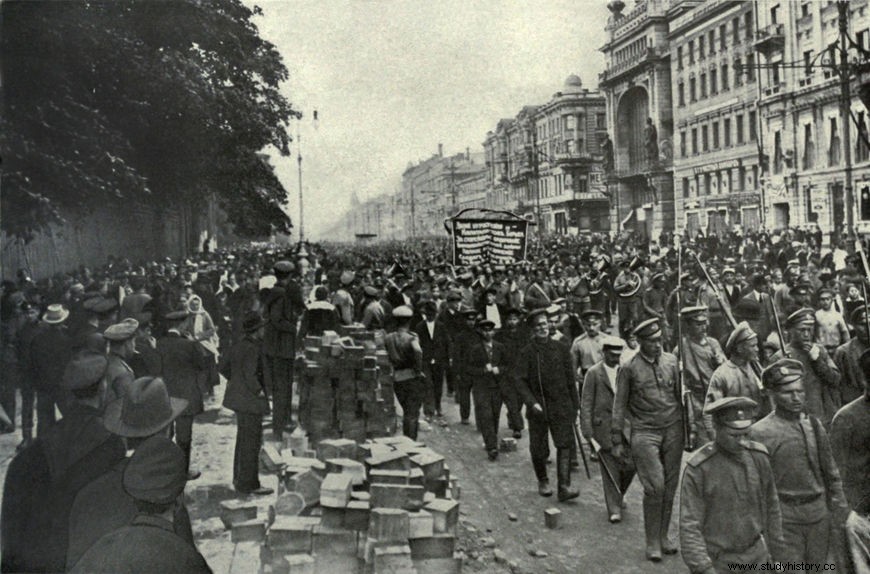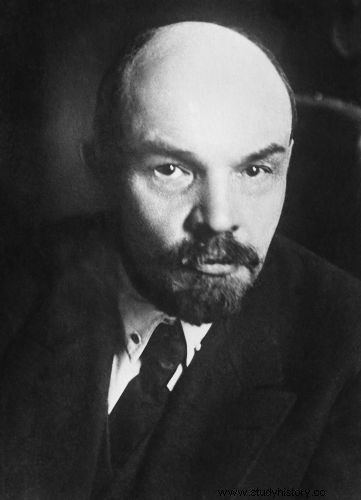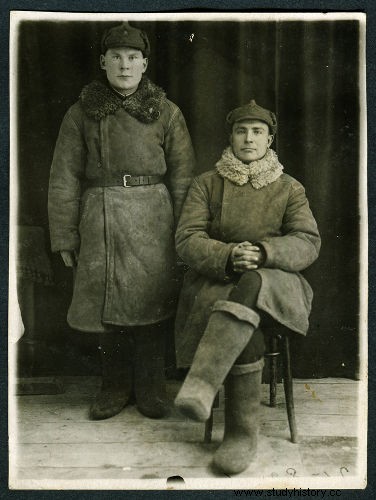The Russian Civil War was a conflict that took place in Russia, between 1918 and 1921, caused by the mobilization of counterrevolutionary forces, called the White Army, which had the objective of overthrowing the Bolsheviks, a group that had installed itself in Russian power by the Russian Revolution of 1917.
The Russian Civil War contributed to a worsening situation in a country already impoverished by centuries of tsarism and its involvement in the First World War. The victory of the Bolsheviks, via Army Red , consolidated this group in the power of Russia. After the Russian Civil War, the Soviet Union was founded.
Russian Revolution of 1917

The Russian Civil War is a direct consequence of the Russian Revolution , mainly because of the Revolution from October . That month, in 1917, the Bolsheviks managed to seize power in Russia by taking control of Petrograd, the capital at the time. This event marked the end of the government of Alexander Kerensky, installed in power since the fall of tsarism.
With this new power, a series of transformations took place, like the assembly of a State in its molds. One of his first measures, under Lenin's leadership, was to withdraw Russia from the First World War by signing a peace treaty with the Germans, the Brest-Litovsk Treaty .
The Bolsheviks' rise to power in Russia generated immediate reactions inside and outside the country. This opposing reaction was a very heterogeneous group that had supporters of different ideological hues, such as anarchists , monarchists and revolutionary socialists . It was this formulation of resistance groups against the Bolshevik revolution that started the civil war.
Also visit :Discover the history of one of Russia's great cities
Russian Civil War Motive
We can say that the reason fundamental for the war to take place was the existence of counterrevolutionary forces who sought, by armed revolt, to defeat the Bolsheviks. The existence of an opposition to them was natural, but it became radicalized as the Bolsheviks proved to be closed to dialogue.
There is no consensus on the real factors that started this reaction, but two moments can be explored to help us understand the reason for their armed mobilization against the Bolsheviks.

The first moment is the dissolve da Assembly Constituent of Russia, which took place in January 1918. On that occasion, the Socialist Revolutionaries managed to defeat the Bolsheviks in the elections, and then Lenin, leader of the Bolshevik government, chose to dissolve this assembly. Most historians agree that this was one of the decisive factors in the uprising.
The second moment was the output da Russia da war . The Russians accepted harsh conditions from the Germans in Brest-Litovsk, and the surrender outraged reactionary forces who wanted the war to continue. These factors may have motivated the counterrevolutionary mobilization in Russia.
Type precedents already existed in the region, as a group of rebels led by Larv Kornilov, who, since 1917, tried to seize power in the country. Kornilov even formed one of the forces that fought the Bolsheviks during the Russian Civil War.
Who fought this war?
Throughout the three years of the Russian Civil War, a multitude of forces fought each other, motivated by different interests. The two main forces were the whites and the reds , although there were others, such as the greens and the black . This conflict also had the involvement of legions of foreign soldiers who invaded Russia to overthrow the revolution or to take advantage of the Russian weakening and take over the country's territories.
The Reds were part of the Red Army, which had been formed by Lenin as a response to the counterrevolutionary uprising . The whites, in turn, were the aforementioned opposing forces that wanted to overthrow the Bolsheviks of power, and most of them wanted to restore the monarchy tsarist.

There was also international cooperation with the cause of whites, especially for the provision of soldiers and weapons. The greens were country peasants Russians who acted in defense of their local interests , for that they fought against the whites and the reds. The blacks were anarchists from Ukraine who fought for the soviets and for the implementation of a self-managed society .
Also visit :Discover the history of the great famine that hit Ukraine during the Stalinist regime
Key Events
Most historians say that the Russian Civil War lasted from 1918 to 1921, although there are some who argue that it started as early as the end of 1917.
One feature of this clash was the fact that whites do not form a unified movement, for the only thing that united them was the desire to overthrow the Bolsheviks. Thus, throughout the war, there were different white troops based on different interests and strategies.
One of the white troops was the Army Volunteer , formed in the southern region of Ukraine and led by Alekseev and Kornilov. This army later merged with a force of Cossacks formed nearby. In addition, it became Armed Forces of Southern Russia from 1919 and, under the leadership of Anton Denikin, assumed power after Alekseev and Kornilov died. This group was the main force opposing the Bolsheviks in the civil war, but from September 1919 it began to weaken due to strategic errors.
After the army led by Denikin fled Russia, white resistance weakened considerably. Other counterrevolutionary movements were organized in other parts of the territory. There was backlash against the Bolsheviks in Siberia , in Petrograd and even in the new capital, Moscow .
Regarding foreign troops, we can also highlight the British action , who invaded Russian territory in the Central Asian region, and the Japanese , who invaded it in the Far East. These invasions by foreign nations enabled the Bolsheviks to exploit the narrative of international imperialist mobilization against the revolution . Between 1920 and 1921, they managed to defeat the counterrevolutionary forces.
Understanding the Bolshevik Victory
The Bolshevik victory can be explained logistically and strategic . The fact that the Red Army controlled central territories in Russia gave them an important advantage:the locomotion of troops and resources was simpler and faster. Furthermore, the Bolsheviks took advantage of the fact that they had the state machine in their favor.
This made it so they could mobilize soldiers and resources in a more way easy than their opponents, who, in general, controlled small territories. During the war, the Bolsheviks appropriated grain production so that the Red Army could be supplied.
The continuation of this situation has generated hunger and revolt in the Russian countryside. Historian Daniel T. Orlovsky mentions that regions such as Tambov saw enormous tensions between peasants and representatives of the Red Army|1| . The famine within the Russian territory was responsible for the death of millions of people .
Furthermore, the ideology of the Bolsheviks had a very great power of attraction over the working class, and this resulted in a very strong support of this class for the Red Army. mediocrity in military command of whites is also highlighted by Daniel T. Orlovsky as a factor that explains its failure|2| .
Also visit :See the massacre carried out by the Soviet Union in Poland during World War II
Consequences
Among the consequences caused by three years of war, we can mention:
-
Consolidation of the Bolsheviks in Russian power;
-
Weakening of dissent within Russian territory;
-
Emergence of the Soviet Union;
-
Supply crisis that resulted in the death of millions of people from starvation;
-
Enormous death toll which, according to different surveys, points to the death of 4 to 10 million people .
-
Opening up the country's economy as a means of rapid recovery of the Russian economy.
Notes
|1| ORLOVSKY, Daniel S. Russia in War and Revolution. In.:FREEZE, Gregory L. History of Russia. Lisbon:Editions 70, 2017, p. 326.
|2| Ditto, p. 322-323.
Image credits
[1] Everett Historical and Shutterstock
[2] Galaymin Sergej and Shutterstock
